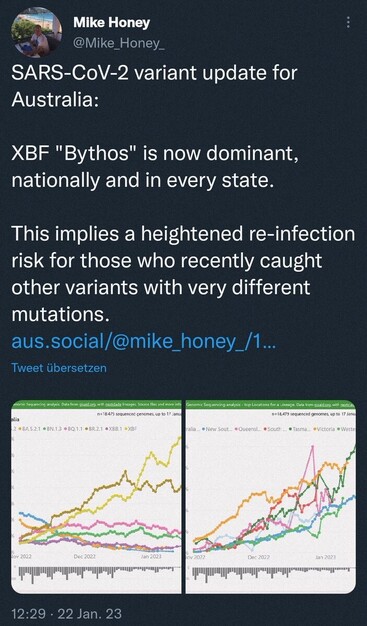Mike Honey · @mike_honey_
2278 followers · 1090 posts · Server aus.socialHere's the latest variant picture for Queensland.
XBB.1.5 "Kraken" (23%) is dominant, but seems to be in decline.
XBF "Bythos" (14%) is hanging on stubbornly.
The sample volumes seem representative up to March 20.
#COVID19 #Australia #QLD #Brisbane #XBB_1_5 #Kraken #XBF #Bythos #FK_1 @auscovid19
🧵
#COVID19 #australia #qld #brisbane #xbb_1_5 #kraken #xbf #bythos #fk_1
Mike Honey · @mike_honey_
2266 followers · 1021 posts · Server aus.socialHere's the latest SARS-CoV-2 variant picture for New Zealand:
XBB.1.5 "Kraken" (36%) became dominant in early March.
It's main rival recently has been the resurgent CH.1.1 "Orthrus" (20%). This variant is hanging on impressively in NZ - in other countries where CH.1.1 was strong, it had faded below 10% by mid-February, as XBB.1.5 took over.
Newcomer XBB.1.9.1 "Hyperion" (7%) has been rising steadily.
XBF "Bythos" has faded below 5%.
Recent sample sizes are very solid and recent, up to March 11 (see grey column chart). However the cadence of updates appears to be roughly monthly, unfortunately.
#COVID19 #NZ #XBB_1_5 #CH_1_1 #Orthrus #Kraken #XBB_1_9_1 #Hyperion #XBF #Bythos
🧵
#COVID19 #nz #xbb_1_5 #ch_1_1 #orthrus #kraken #xbb_1_9_1 #hyperion #xbf #bythos
Dr A. Capolongo :mastodon: · @DrACapolongo
546 followers · 1992 posts · Server med-mastodon.com#Covid19, #Bythos nuova sottovariante monitorata dall'OMS
📌 Sigla ufficiale XBF, nickname 'Bythos' come l'ittiocentauro personificazione degli abissi marini, busto umano, zampe anteriori di cavallo e coda di pesce. E' l'ultima sottovariante di Sars-CoV-2 che l'Organizzazione mondiale della sanità ha inserito nella lista dei sottolignaggi di Omicron 5 tenuti sotto stretto monitoraggio per caratteristiche spia di maggiore trasmissibilità e fuga immunitaria.
https://www.adnkronos.com/covid-bythos-nuova-sottovariante-monitorata-dalloms_4BGQeTa26SzRO9rry349TK
Mike Honey · @mike_honey_
2246 followers · 913 posts · Server aus.socialLast week a new possible sub-variant of XBF "Bythos" was proposed by Ryan Hisner - characterised by the unusual Spike P621S mutation. The earliest sample reported was from New South Wales, back in October (not shown). Most of the samples globally have been found in South Australia, reporting rapid growth to 12% frequency in mid-February. After very sparse samples elsewhere, the steady growth on consecutive days seems to confirm community spread in South Australia.
I'm searching for those samples here by looking for samples of XBF with the Spike P621S mutation. There are 45 reported globally so far, with a couple in Singapore and 8 in the UK.
#COVID19 #australia #xbf #bythos
Mike Honey · @mike_honey_
2221 followers · 883 posts · Server aus.socialIn recent days a new variant has been proposed - a recombinant of BR.2.1 "Cerastes" and XBF "Bythos". The earliest sample reported so far was from Victoria, in mid-January. All the samples globally have been found in Australia - covering New South Wales, Queensland and South Australia.
Recombinant variants typically arise when an immune-compromised patient is infected with multple variants at once. The more often that happens, and the longer the co-infection, the more chances of recombinant variants being formed and spreading to the broader population.
As recombinant variants have become more common, they are involved in more of these scenarios. This gives the virus a multiplier in it's constant search to find new, more evasive combinations.
I'm searching for those samples here by looking for samples with the Spike F486P and NS8 S82T mutations. There are 10 so far, rising to around 1.5% frequency for Australia. There's now very limited genomic sequencing data shared from other states besides NSW, so this could be going undetected elsewhere.
#COVID19 #Australia #XBF #Bythos #BR_2_1 #Cerastes @auscovid19
🧵
#COVID19 #australia #xbf #bythos #br_2_1 #cerastes
Mike Honey · @mike_honey_
2220 followers · 878 posts · Server aus.socialHere's the latest SARS-CoV-2 variant picture for New Zealand:
The XBF "Bythos" variant has grown steadily to 21%, and is now the dominant individual variant. XBB.1.5 "Kraken" has grown to 10%.
The BA.2.75.* clan variants are led by CH.1.1 "Orthrus" at 16%, followed by child CH.1.1.7 at 14%. BR.2.1 "Cerastes" is at 10%.
The BQ.* and BA.5.* variants continue to fade, down to 5% or less.
Definitely a swarm of variants about, but the trend is towards the recombinant variants with the Spike F486P mutation: XBF and XBB.1.5,
Recent sample sizes are very solid and recent, up to February 6 (see grey column chart).
#COVID19 #NZ #XBF #Bythos #XBB_1_5 #Kraken #XBB_1_9_1 #Hyperion
🧵
#COVID19 #nz #xbf #bythos #xbb_1_5 #kraken #xbb_1_9_1 #hyperion
Mike Honey · @mike_honey_
2199 followers · 812 posts · Server aus.socialHere's the latest variant picture for Singapore:
After a long lull under the XBB.1 "Hippogryph" variant, new variants are vying for dominance in Singapore, launching a new wave.
The leading candidates so far are CH.1.1.1, a child of "Orthrus" (12%), XBB.1.5 "Kraken" (11%) and XBF "Bythos" (reached 10%, possibly fading).
The fairly strong showing by XBF might help explain why XBB.1.5 has been so slow to take off in Australia, where XBF is dominant.
Recent samples look representative, up to 29 January.
#COVID19 #Singapore #CH_1_1_1 #Orthrus #XBB_1_5 #Kraken #XBF #Bythos
🧵
#COVID19 #singapore #ch_1_1_1 #orthrus #xbb_1_5 #kraken #xbf #bythos
wohllust · @franklutze
0 followers · 744 posts · Server social.anoxinon.deRT @moogoonoog
Was momentan in Australien passiert, klingt sehr beunruhigend.
Mike Honey · @mike_honey_
2145 followers · 756 posts · Server aus.socialHere's the latest variant picture for Sweden:
The clan of BQ.* lineages (50%) - led by the BQ.1.1 "Cerberus" lineage (17%) - rose to dominance during November, starting a wave of cases and deaths.
XBF "Bythos" (10%) rose sharply during early January.
XBB.1.5 "Kraken" is present (2%), but is not growing as fast as XBF. XBF is rated just below XBB.1.5 for immune escape, and slightly higher for ACE2 binding (see below), so it will be interesting to see how that plays out.
Recent sample sizes are smaller.
#COVID19 #Sweden #BQ #Cerberus #XBF #Bythos #XBB_1_5 #Kraken
🧵
#COVID19 #sweden #bq #cerberus #xbf #bythos #xbb_1_5 #kraken







